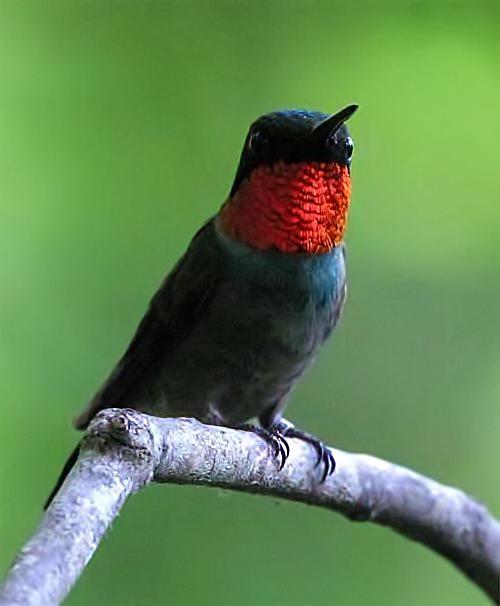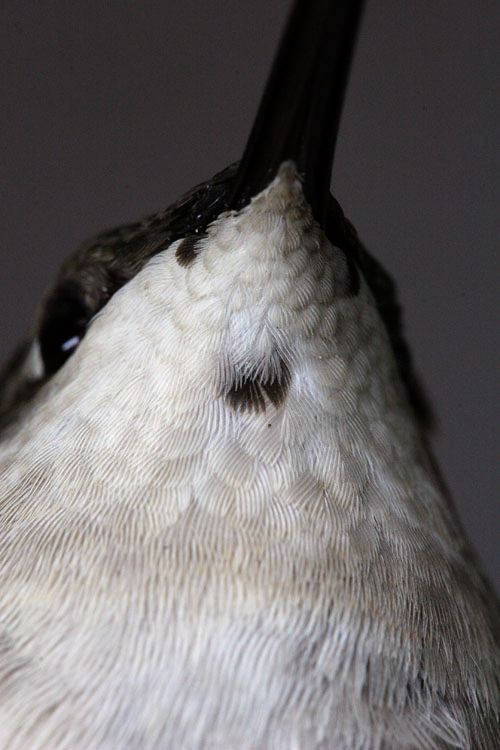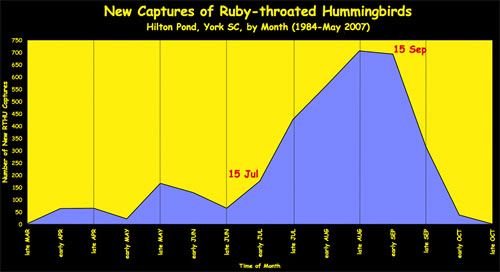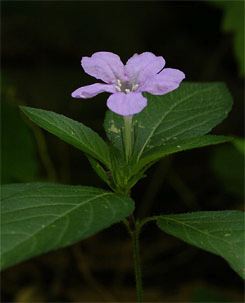|
|
|||
|
(Back to Preceding Week; on to Next Week) |
|
RETURN OF THE RUBY-THROATS, 2007
Most years at Hilton Pond Center we sit sad-faced and pouty through the months of April, May, and June as other banders around the country brag they have oodles of Ruby-throated Hummingbirds while we are lucky to capture one or two per week. We do hear from other hummer enthusiasts who say they also get hummers in April that disappear and who--like us--lament they see few or no ruby-throats at their feeders during May. We always remind them: 1) many of those early arrival hummers might have been moving further north; 2) resident female RTHU are already sitting on eggs in April and May and are less likely to make frequent feeder visits; 3) another bunch of RTHU should show up around the third or fourth week in May (at least for sites at about the same latitude as Hilton Pond); and, 4) as spring progresses there are more and more natural foods available Thus, it's important to keep the feeders fresh because by about the Fourth of July hummingbird fireworks will erupt as many youngsters are fledging, resident males are trying to attract females for one last stab at procreating, and--believe it or not--some early fall migrant RTHU are already starting to move south.
All text, charts & photos © Hilton Pond Center So far 2007 has been different for us at Hilton Pond, with numerous other banders lamenting dismal numbers while we've had the distinct pleasure of lots more RTHU than usual--including adult males we've captured, banded on the left leg, and color marked with green dye on the breast (above). In fact, through the end of May we've been setting records for numbers of new RTHU banded locally AND for old ones returning from previous years--pretty significant because this is our 24th year of studying Ruby-throated Hummingbirds in the Carolina Piedmont. We spotted our first ruby-throat of 2007 (a male) on 31 March but didn't capture any until 16 April (see red line on chart above); this is considerably later than our early banding record of 27 March 1991. (Most years we band our first hummer on or before 10 April.) Hummer activity remained rather slow this spring--only five total bandings through 23 May--but then things exploded, with 23 birds banded over the next seven days. As of 30 May we had banded 28 RTHU for the 2007 season--ten males and 18 females, and four birds ahead of the next highest total of 24 by that date back in 2000. Even more amazing was the influx during May of Ruby-throated Hummingbirds we banded in previous years. Our first return for 2007 came on 16 April--a second-year male banded as a juvenile on 27 July 2006--and we trapped or netted four more "old" RTHU through April. As with the new captures, returns were very slow to accumulate in May; in fact, we had no more recaptures at all until 21-22 May when we caught eight. During the remainder of the month, returns mirrored new captures; we caught 20 more old birds by 30 May, bringing the 2007 total for recaptures from previous years to 33--five more than our total for NEW bandings this year. This recapture tally is of particular significance because our all-time record for returns in one year is 36 (in 2000), while the average for complete field seasons over the past 24 years is just 26--and the hummingbird season's not half over yet. (June and July are always good months for returns; we've had first encounters with previously banded birds as late as 8 September.) The list of our previously banded Ruby-throated Hummingbirds that already have showed up at Hilton Pond Center so far in 2007 is quite impressive, so we include it below in its entirety:
Folks who like to burrow into tables like the one above may see some patterns--we hope your eyes don't glaze over and you at least take a look--but for the sake of discussion we'd like to point out a few particulars. So far only three of our returning ruby-throats this year were banded as adult (after hatch year) males, but two of those are quite significant. On 24 May, we netted a red-throated male hummer with a familiar band number, Y15131; we banded this bird as an adult in July 2002, and he's been back every year since--making him an after sixth year bird that had to have hatched out no later than the summer of 2001. This individual is our oldest male RTHU ever at Hilton Pond Center, but Y15190--banded in August 2002 as a juvenile and recaptured on 26 May 2007--also has returned each year and himself has a known age of six years. These two are creeping toward nine years, the known age record for a wild RTHU. Also of interest this week are two old returning females, Y15311 and Y15332. Each was banded as an adult female in the summer of 2003 and recaptured on 30 May this year, which makes them both after fifth year birds. It's interesting that Y15311 was recaptured in 2004 and 2006 but not in 2005, while Y15332 wasn't seen in 2004 but has been caught each year since. We suspect both birds were in the vicinity of Hilton Pond for those "missing years" and we simply weren't able to catch them.
One other unusual thing about Y15332 is that for the past three years she has had a single black feather in the middle of her otherwise pristine white throat, as illustrated in the photo above taken during this year's recapture. Female RTHU often bear throat feathers with centers of very pale gray--different from the greenish or blackish streaking seen in some juvenile males-- but only two or three of the 600-plus adult females we've banded at Hilton Pond Center since 1984 have exhibited a black spot. Also of interest in the photo above is a band of light brown about where the female's throat feathers meet those on her breast. This is a "nest mark" that forms as the incubating female's body contacts the upper rim of her nest. In some hummingbirds the nest mark is pronounced--occasionally the plumage gets very discolored and compressed--and can be seen on females as they hover at a feeder. One other comment about the 33 RTHU that have returned to the Center so far in 2007: Eight were banded in earlier years as juvenile males, nine as juvenile females, 13 as adult females, and just three as adult males. This is not an aberration but leans toward the general age-sex ratio of RTHU captured over 24 years at Hilton Pond, where juvenile males outnumber juvenile females 3:2, and adult females outnumber adult males by the same ratio. Having a late May influx of ruby-throats is also par for the course at the Center, even in years when we don't have many. As shown by the chart just above, we get an early peak of hummers between mid- and late April, only to have numbers of new birds drop off around the first of May. Then there's what we call our "second wave" of RTHU in late May, followed by another lull that continues until early July. Finally, beginning around 15 July, the population explodes as the current year's nestlings fledge and start bumbling into nets and traps, with a sharp drop-off do new birds after 15 September. Thus, even though we're flush with success during the last half of May this year, we're betting we won't catch many RTHU over the next few weeks. Our Trumpet Creeper vines undoubtedly will erupt with tubular, orange, nectar-laden flowers during the first week in June while fast-growing nestlings will demand their mothers also feed them fat- and protein-rich insects for breakfast, lunch, and dinner. These factors will divert Ruby-throated Hummingbirds from our feeders, but we know from experience by mid-July we'll seeing a second return of hummers to our Hilton Pond banding table in 2007. All text, charts & photos © Hilton Pond Center
Comments or questions about this week's installment?
Thanks to the following fine folks for recent gifts in support of Hilton Pond Center for Piedmont Natural History and/or Operation RubyThroat: The Hummingbird Project. Your tax-deductible contributions allow us to continue writing, photographing, and sharing "This Week at Hilton Pond." (Please see Support if you'd like to make a gift of your own.)
IMPORTANT NOTE: If you ever shop on-line, you may be interested in becoming a member of iGive, through which nearly 700 on-line stores from Barnes and Noble to Lands' End will donate a percentage of your purchase price in support of Hilton Pond Center and Operation RubyThroat. We've just learned that for every new member who signs up and makes an on-line purchase within 45 days iGive will donate an ADDITIONAL $5 to the Center. Please sign up by going to the iGive Web site. It's a painless and important way for YOU to support our work in conservation, education, and research. "This Week at Hilton Pond" is written & photographed You may wish to consult our Index of all nature topics covered since February 2000. You can also use our on-line Hilton Pond Search Engine at the bottom of this page. For a free, non-fattening, on-line subscription to |








 Please report your
Please report your
